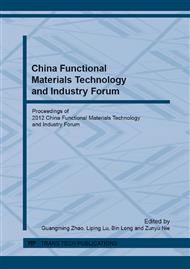[1]
LAZAREVSKA M, KNEZEVIC M, CVETKOVSKA M. Application of artificial neural networks for prognostic modeling of fire resistance of reinforced cement pillars [J]. Applied Mechanics and Materials, 2012, 148-149: 856-861.
DOI: 10.4028/www.scientific.net/amm.148-149.856
Google Scholar
[2]
SARSHAR R, KHOURY G A. Material and environmental factors influencing the compressive strength of unsea-led cement paste and cement at high temperatures [J]. Mag Concr Res, 1993, 45: 51-61.
DOI: 10.1680/macr.1993.45.162.51
Google Scholar
[3]
GHOSH S, NASSER K W. Effects of high temperature and pressure on strength and elasticity of lignite fly ash and silica fume cement [J]. J Aci Mater, 1996, 93: 51-60.
DOI: 10.14359/9795
Google Scholar
[4]
FIRMO J P, CORREIA J R.; FRANÇA P. Fire behaviour of reinforced cement beams strengthened with CFRP laminates: Protection systems with insulation of the anchorage zones [J]. Composites Part B, 2012, 43(3,): 1545-1556
DOI: 10.1016/j.compositesb.2011.09.002
Google Scholar
[5]
MARTINOLA G, BÄUML M F. WALLISER A. Numerical modeling of the long-term behavior of passive fire protection mortars applied on cement tunnels [J]. J Mater in Civil Eng, 2007, 19(6): 484-491.
DOI: 10.1061/(asce)0899-1561(2007)19:6(484)
Google Scholar
[6]
WITEK A, GAWIN D, PESAVENTO F AND SCHREFLER B A. Finite element analysis of various methods for protection of cement structures against spalling during fire [J]. Comput Mech, 2007, 39(3): 271-292.
DOI: 10.1007/s00466-005-0024-7
Google Scholar
[7]
PARK S H, CHOI S M; CHUNG K S. A study on the fire-resistance of cement-filled steel square tube columns without fire protection under constant central axial loads [J]. Steel and Composite Structures, 2008, 8(6): 491-510.
DOI: 10.12989/scs.2008.8.6.491
Google Scholar
[8]
MELBYE TOM, DIMMOCK, R. Thermal barriers and fibre cement roles in the passive fire protection of tunnels [J]. Proceedings of the Tenth International Conference on Shotcrete for Underground Support, 2006, 215: 285-297.
DOI: 10.1061/40885(215)23
Google Scholar
[9]
HEO Y S, SANJAYAN J G, HAN C G AND HAN MC. Critical parameters of nylon and other fibres for spalling protection of high strength cement in fire [J]. Mater and Struct, 2011, 44(3):599-610.
DOI: 10.1617/s11527-010-9651-3
Google Scholar
[10]
JOaO, P C. RODRIGUES, L L, ANTÓNIO M C. Behaviour of fiber reinforced cement columns in fire [J]. Compos Struct, 2010, 92: 1263-1268.
Google Scholar
[11]
LIN T D, CHOU S. Cement fire test programs in Taiwan.KI-ST Special Publication, 1996, 919: 55-58.
Google Scholar
[12]
KASZYŃSKA M. Early age properties of high-strength /high-performance cement [J]. Cem and Concr Compos, 2002, 24: 253-261.
DOI: 10.1016/s0958-9465(01)00014-2
Google Scholar
[13]
PHAN L T. Pore pressure and explosive spalling in cement, Mater and Struct [J]. 2008, 41(10): 1623-1632.
DOI: 10.1617/s11527-008-9353-2
Google Scholar
[14]
SARSHAR R, KHOURY G A. Material and environmental factors influencing the compressive strength of unsea -led cement paste and cement at high temperatures [J]. Mag Concr Res, 1993, 45: 51-61.
DOI: 10.1680/macr.1993.45.162.51
Google Scholar
[15]
BOUGUERRA A. Effect of microstructure on the mechanical and thermal properties of lightweight cement prepared from clay, cement and wood aggregates [J]. Cem and Concr Res, 2001, 8: 1179-1190.
DOI: 10.1016/s0008-8846(98)00075-1
Google Scholar


